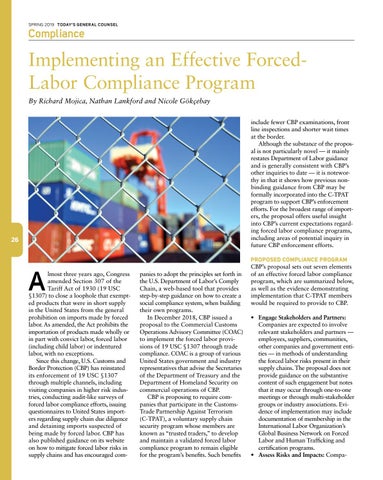SPRING 2019 TODAY’S GENER AL COUNSEL
Compliance
Implementing an Effective ForcedLabor Compliance Program By Richard Mojica, Nathan Lankford and Nicole Gökçebay include fewer CBP examinations, front line inspections and shorter wait times at the border. Although the substance of the proposal is not particularly novel — it mainly restates Department of Labor guidance and is generally consistent with CBP’s other inquiries to date — it is noteworthy in that it shows how previous nonbinding guidance from CBP may be formally incorporated into the C-TPAT program to support CBP’s enforcement efforts. For the broadest range of importers, the proposal offers useful insight into CBP’s current expectations regarding forced labor compliance programs, including areas of potential inquiry in future CBP enforcement efforts.
26
PROPOSED COMPLIANCE PROGRAM
A
lmost three years ago, Congress amended Section 307 of the Tariff Act of 1930 (19 USC §1307) to close a loophole that exempted products that were in short supply in the United States from the general prohibition on imports made by forced labor. As amended, the Act prohibits the importation of products made wholly or in part with convict labor, forced labor (including child labor) or indentured labor, with no exceptions. Since this change, U.S. Customs and Border Protection (CBP) has reinstated its enforcement of 19 USC §1307 through multiple channels, including visiting companies in higher risk industries, conducting audit-like surveys of forced labor compliance efforts, issuing questionnaires to United States importers regarding supply chain due diligence and detaining imports suspected of being made by forced labor. CBP has also published guidance on its website on how to mitigate forced labor risks in supply chains and has encouraged com-
panies to adopt the principles set forth in the U.S. Department of Labor’s Comply Chain, a web-based tool that provides step-by-step guidance on how to create a social compliance system, when building their own programs. In December 2018, CBP issued a proposal to the Commercial Customs Operations Advisory Committee (COAC) to implement the forced labor provisions of 19 USC §1307 through trade compliance. COAC is a group of various United States government and industry representatives that advise the Secretaries of the Department of Treasury and the Department of Homeland Security on commercial operations of CBP. CBP is proposing to require companies that participate in the CustomsTrade Partnership Against Terrorism (C-TPAT), a voluntary supply chain security program whose members are known as “trusted traders,” to develop and maintain a validated forced labor compliance program to remain eligible for the program’s benefits. Such benefits
CBP’s proposal sets out seven elements of an effective forced labor compliance program, which are summarized below, as well as the evidence demonstrating implementation that C-TPAT members would be required to provide to CBP. • Engage Stakeholders and Partners: Companies are expected to involve relevant stakeholders and partners — employees, suppliers, communities, other companies and government entities — in methods of understanding the forced labor risks present in their supply chains. The proposal does not provide guidance on the substantive content of such engagement but notes that it may occur through one-to-one meetings or through multi-stakeholder groups or industry associations. Evidence of implementation may include documentation of membership in the International Labor Organization’s Global Business Network on Forced Labor and Human Trafficking and certification programs. • Assess Risks and Impacts: Compa-

